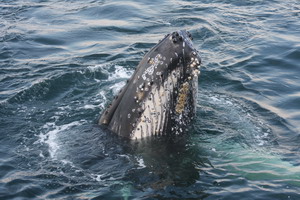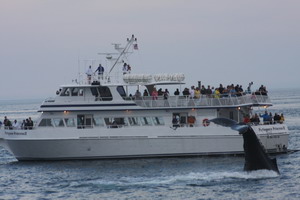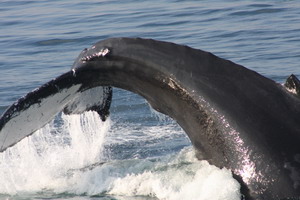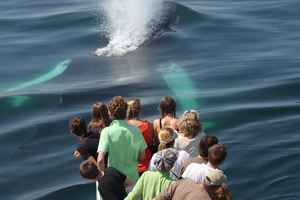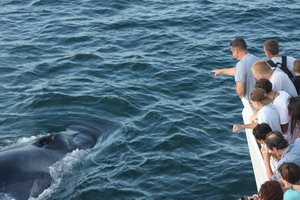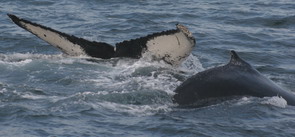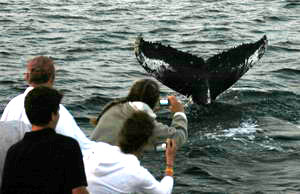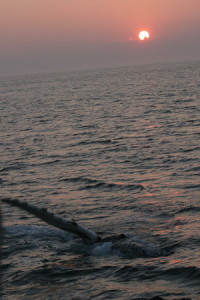Dolphin Fleet Naturalist Notebook 26 July to 01 August
On 26 July the Dolphin VII started out the week by heading up to the Southwest Corner of Stellwagen Bank, a favorite feeding hub for many of our humpback whales. Mars, Draco, and Reflection were among the humpbacks who were blowing clouds of bubbles and then lunging through the trapped schools of fish at the surface. Leukos, a female, here this summer with a calf, was also feeding away while the calf hung out at the periphery of the feeding circle, occasionally peering up at the boat.
The southern Gulf of Maine, and Stellwagen Bank in particular, is sometimes referred to as a “nursery” for humpbacks. Adult females will bring their calves here in the springtime so that the mothers can feed on the sand lance which tends to be readily available. Frequently, older, more experienced humpbacks unencumbered by a demanding calf, will spend more time in areas where herring are the food of choice, as this prey item tends to require a bit more energy to acquire. However, humpback whales are very likely to return to the same feeding ground that their mothers brought them to during their first years of life.
In the early afternoon, the Dolphin VIII arrived on the scene just as the feeding frenzy was coming to an end. Fortunately, the humpbacks were exciting in other ways. Contented after a morning of feeding, Seal, an adult male, spent much of the trip flipper slapping, lobtailing, and even breaching!
Fisherman used to the rhythms of the fish know that you are more likely to catch certain types of fish at certain times of day. However, there is no “best time” to catch humpback whales feeding on our trips. This was evident on July 27th when our humpbacks proceeded to feed all day long! Despite the grey and sometimes rainy weather, we got a chance to see three different types of whale–the humpback, the fin whale and the Minke.
While the dramatic feeding behaviors of the humpbacks are easy to spot, getting a good look at a Minke whale can be a little more tricky. They are the smallest of the baleen whales that we are likely to encounter on our trips, and despite their relative abundance, spend very little time at the surface. At first glance, they are sometimes mistaken for a dolphin or porpoise, but they are actually quite a bit larger, and at times reach lengths of 25 feet. As humpbacks, including Alphorn and Rattan blew bubble nets and emerged at the surface, these Minkes could be seen darting around through the area, also here to feed on small schooling fish.
On July 28, many of our excursions out to Stellwagen Bank were seeing between 20 and 35 whales per trip! “Total chaos!” exclaimed one of our naturalists, grinning as we approachine a line of humpbacks, still gathered near the Southwest corner of Stellwagen Bank, an area of frequent upwelling and nutrient cycling. These animals were lined up along a visible upwelling line and blowing spiraling columns of bubbles, coming up through them with the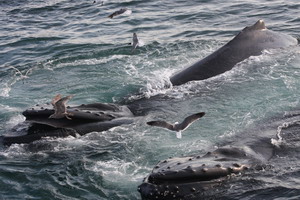 ir mouths open. Once they are at the surface, they will frequently “drag”, and “snake” using their enormous, agile flippers to keep them at the surface while all of the remaining water drains between their baleen plates and out the sides of thier mouths.
ir mouths open. Once they are at the surface, they will frequently “drag”, and “snake” using their enormous, agile flippers to keep them at the surface while all of the remaining water drains between their baleen plates and out the sides of thier mouths.
Later, the Dolphin VIII as well as the Dolphin Fleet’s newest boat, the Portuguese Princess II watched as Filament, a humpback whale with an almost all white fluke, engaged in a behavior known as kick feeding. As she raised her fluke and tail stock out of the water, we could see the notch-like scar in her tail stock–a sure sign of a previous entanglement in fishing gear. Filament would then slam her tail down, stunning schools of fish, which she would then scoop up with her enormous, reservoir-like mouth.
On July 29, we had one of our favorite humpbacks, a male who is almost thirty years old, make an appearance. Colt is famous for his long-last boat approaches, and today the Dolphin VIII was lucky enough to experience this first hand. Colt, characterized by his rounded, floppy dorsal fin, swam back and forth under the boat, surfacing under the bow sprit and startling passengers with his loud, misty exhalation.
While it is not altogether uncommon for humpbacks to approach boats, it is less likely to get a good, up-close look at a fin whale. Today, the Dolphin VII got a brief glimpse of the long, sleek, fin whale, as it surfaced off the port side. When the fin whale is that close, you can get a real sense of its size. The fin whale is the second largest animal on the planet, and can grow to be over 75 feet long!
By June 30, the whales had shifted to the southwest, but the feeding was business as usual. In the morning, we began our trip with Dome, a 22 year old female, and her seventh calf. As Dome was kick feeding and blowing bubble clouds to trap fish, her calf was causing a ruckus, trying to get mom’s attention. The calf breached, rolled, and flipper slapped. For unknown reasons, Dome has a very loud, thunderous exhale, and we could hear her every time she surfaced. Division and her calf made an appearance later in the trip, giving passengers the chance to see the abundance of mother humpbacks caring for their 6-month old calves.
Division and calf
Upon our return later in the afternoon, the feeding continued and we watched as three whales fed side by side. Two would work blow a bubble cloud together, simultaneously rising up through the fish schools with their mouths open. Next to the pair, a third humpback would kick feed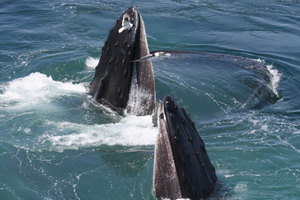 , highlighting the differences in feeding preferences among our southern Gulf of Maine humpbacks.
, highlighting the differences in feeding preferences among our southern Gulf of Maine humpbacks.
On July 31, the fog rolled in during the morning. We slowly made our way up to the southern edge of Stellwagen Bank. When we arrived, we had less than 100 feet of visibility, so we all sat still and listened for the unmistakeable sound of a large whale exhaling. When whales dive, they pressurize the air in their lungs. When they come up to exhale, we can hear that pressure release just like we can hear a “pop” when we open a can of soda. Soon, we heard a whale surface and could see the flat patch on the water left behind by the whale’s motion. Before we knew it, we were surrounded by feeding humpback whales, and as we watched them feed, the skies gradually cleared.
This left us with ideal conditions for the afternoon trips. On this trip, we headed eastward, not straying very far from shore. With Provincetown’s unique parabolic dunes providing a scenic backdrop for our whale watch, we found ourselves among humpbacks, as well as a fin whale mother and calf.
calf.
On August 1, we had an exciting look at wildlife early in the trip. As we cruised by Herring Cove Beach at the edge of Cape Cod Bay, we noticed a disturbance in the water. Bluefin tuna could be seen chasing bluefish through the water with such voracity that they were leaping out of the air!
Bluefin tuna are remarkable fish for many reasons. They have the highest metabolic rate of any other fish, and even retain some of their metabolic heat, which is a characteristic of warm-blooded animals, but not most fish. They have an extensive migratory range, and will even cross the Atlantic during migrations, returning to the Gulf of Maine to feed on a variety of creatures, including herring, sand lance and squid. They’ve even been known to eat lobster and sponge! As adults, they are prized by fisherman, and can weigh several hundred pounds. Unfortunately, their stocks seem to be declining, making our sighting off of Herring Cove all the more noteworthy.
Once we reached Stellwagen, the humpbacks were abundant. During the afternoon we saw both Columbia, as well as her 2006 calf. Although these two animals are no longer traveling together, the fact that the young whale has returned to its mother’s favorite feeding ground is no surprise. Now that this whale has been documented for a second year, it can be named next April. Whales are named based on patterns on the underside of their tails. In the photo below, see if you can see Elephant’s “elephant” pattern on the left fluke.
As the sun began to set and we headed back home, Elephant began to roll on its side, it’s bright white flipper contrasting the raging orange of the sky. August marks the beginning of our busiest season here in Provincetown, but out on the water, we are able to escape from the hustle and bustle and think about the pristine natural environment that is right here in our back yard.






